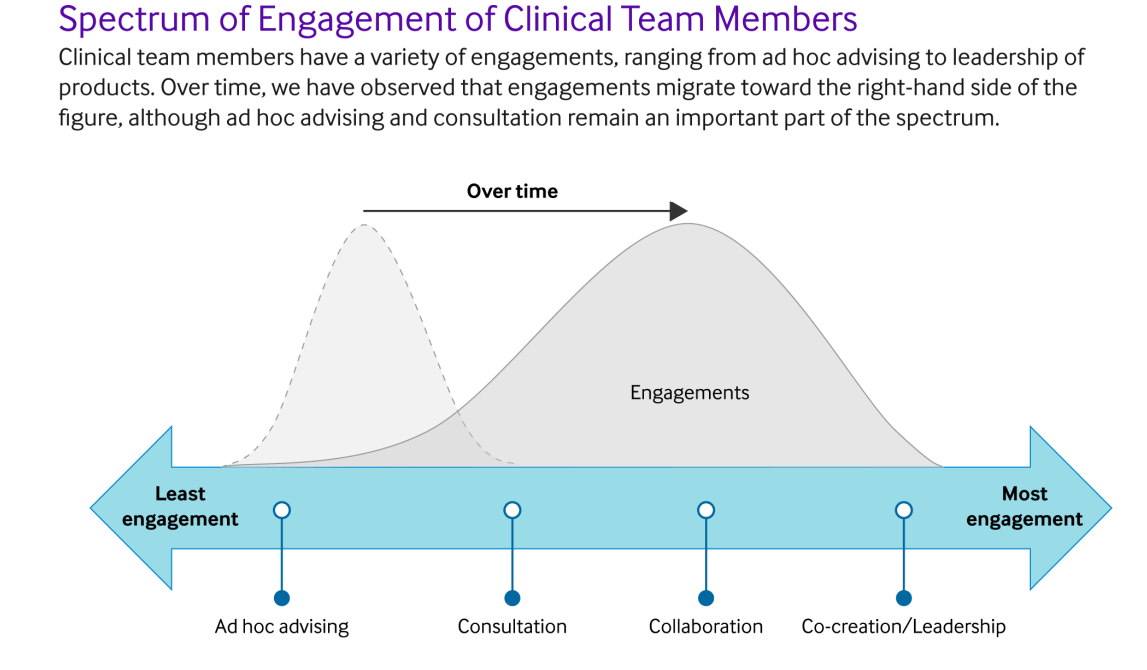the health strategist
research and strategy institute
for continuous health transformation
and digital health
Joaquim Cardoso MSc
Chief Researcher & Editor of the Site
April 11, 2023
ONE PAGE SUMMARY
Summary
Technical innovations over the past 20 years have changed the way we live many parts of our daily lives, but there is resounding agreement that progress in health care has not kept pace.
While many believe that technology will improve health outcomes, there is a real and persistent concern that technology companies do not understand the complexity of health and health care.
- This challenge is usually discussed as an either/or problem.
- Either technology companies must disrupt the way that health care works, …]
- … or they won’t succeed because they will never understand the real world of health and health care.
The authors believe that there is a third way — one that establishes a robust, thriving clinical team within a major technology company that brings a deep understanding of the current health care system to bear and a passion to make real improvements.
- However, clinical teams represent new functions for technology companies, and so they also represent a cultural shift.
This article summarizes several years of experience building Google’s clinical team, and later adapting it during Covid-19, to offer six lessons for organizations embarking on similar journeys.
6 Key Lessons
In this article, the authors summarize some of othe learnings in building Google Health’s clinical team, and later adapting it during Covid-19, to offer six lessons for technology companies that want to have a portfolio of health products and services.
- Lesson 1. Clarify the Role of Health Professionals Across the Enterprise
- Lesson 2. Develop, Communicate, and Act on a Consistent Set of Clinical Values
- Lesson 3. Recruit for Talent — but Not Only for Clinical Expertise
- Lesson 4. Develop Clarity on — and Build Consensus Around — New Ways of Working
- Lesson 5. Invest in the Infrastructure That Supports Career Progression
- Lesson 6. Be Ready to Adapt, Grow…and Adapt Again
DEEP DIVE
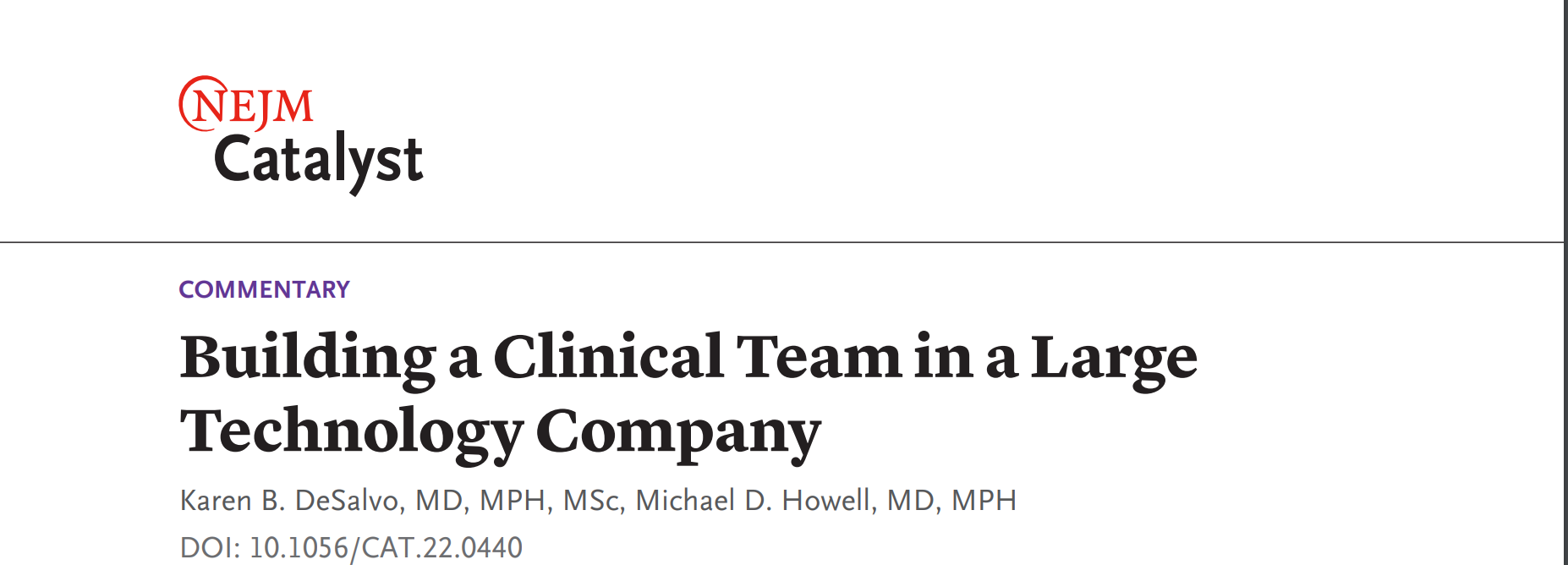
Building a Clinical Team in a Large Technology Company
Six lessons from Google’s health care leaders.
NEJM Catalyst
Karen B. DeSalvo, MD, MPH, MSc and Michael D. Howell, MD, MPH
March 1, 2023
Health has always been central to the operations of any business. After all, 10% of employee compensation is health related, employee illness costs businesses between $225 and $575 billion every year in the U.S. alone, and good employee health translates to better business.1–3 Research solidly indicates that healthier employees are more productive. However, the Covid-19 pandemic helped companies recognize that health has a broader impact on their business, from continuity of operations to new lines of partnership. Health is transforming from a line item in annual budgets to a business imperative for companies across the world.
The recruitment of Chief Health Officers not just in technology companies like Google, where we work, but in industries ranging from travel to retail, signals the increasing strategic priority of health.4–7 These leadership decisions reflect not just a prioritization of health and safety for employees during the pandemic, but they also demonstrate an increased recognition that community and wellness are directly related to the core business as well as a deepened commitment to working with one of the largest sectors of the global economy to address the gaps and opportunities that have been so clearly exposed by the pandemic. These Chief Health Officer roles take many forms, but many have internally and externally facing responsibilities. At many companies, including Google, the emerging portfolio of responsibilities includes not only employee health and safety, but also product stewardship, strategic guidance for health policy and corporate social responsibility, and, in some environments, community health. We have teams that focus on global employee health, on regulatory strategy, and on health equity — but in this article, we focus on the development and function of the clinical team.
Chief Health Officers are typically charged with building clinical teams inside historically nonclinical companies. Fulfilling this responsibility is more easily said than done. Active integration of clinical perspectives into enterprise-wide product decisions creates more benefit for users and the company. However, this task can be difficult because it represents not only new processes, but also because it requires significant change management efforts to ensure a larger cultural shift to reposition clinicians from ad hoc advisors to true collaborators and cocreators of health-related solutions. The need for bridging this cultural gap is nowhere more apparent than in technology-focused businesses in health.8 Our experience and learning from building a clinical team to support product development in a larger technology company is the focus of this article.

The Promise and the Problem
Technical innovations over the past 20 years have changed the way we live many parts of our daily lives, but there is resounding agreement that progress in health care has not kept pace.9 The challenges of using technology to improve health have affected technology companies as well. For example, Google’s early forays into clinical products in 2008, 15 years ago, showed both that technical expertise alone would be insufficient to tackle health care’s thorniest challenges and that the policy and interoperability environments were barriers to significant adoption.10,11 While many believe that technology will improve health outcomes, there is a real and persistent concern that technology companies do not understand the complexity of health and health care.12 This challenge is usually discussed as an either/or problem.13 Either technology companies must disrupt the way that health care works, or they won’t succeed because they will never understand the real world of health and health care. We believe that there is a third way — one that establishes a robust, thriving clinical team within a major technology company that brings a deep understanding of the current health care system to bear and a passion to make meaningful disruptive improvements that improves people’s lives. It’s important to get this right, because technology offers the promise of improving health at scale. Products from large technology companies now reach people at a previously unprecedented scope; for example, Apple, Meta, and Google each have products used by more than a billion people every month.14–16
We believe that there is a third way — one that establishes a robust, thriving clinical team within a major technology company that brings a deep understanding of the current health care system to bear and a passion to make meaningful disruptive improvements that improves people’s lives.
Google has been on this journey for the past several years.
And though we have encountered challenges along the way, we are encouraged by the progress.
In this article, we summarize some of our learnings in building Google Health’s clinical team, and later adapting it during Covid-19, to offer six lessons for technology companies that want to have a portfolio of health products and services.
- Lesson 1. Clarify the Role of Health Professionals Across the Enterprise
- Lesson 2. Develop, Communicate, and Act on a Consistent Set of Clinical Values
- Lesson 3. Recruit for Talent — but Not Only for Clinical Expertise
- Lesson 4. Develop Clarity on — and Build Consensus Around — New Ways of Working
- Lesson 5. Invest in the Infrastructure That Supports Career Progression
- Lesson 6. Be Ready to Adapt, Grow…and Adapt Again

Lesson 1. Clarify the Role of Health Professionals Across the Enterprise
A robust clinical team only makes sense if the company views health as a key part of its mission. Health can mean many different things to a company: oversight of employee well-being; adherence to health and safety regulations in a given industry; product development for consumers, patients, and providers; and partnerships with health systems and biopharmaceutical companies. Are these efforts just a cost of doing business, or are health efforts an important part of how the company creates value? Clarifying this point is a precondition for success. Establishing a Chief Health Officer role in the C-suite can signal a company’s focus on health, but individuals in these roles could just serve as figureheads unless the title is accompanied by a strategic vision and action plan. At Google, our vision is simple: billions of healthier people. To achieve this vision, we focus on improving access to helpful health resources for consumers, for caregivers, and for the community. Turning vision into reality requires a commitment to build a team, design processes, and measure outcomes along the way.
At Google, health has always been important to the work of the company: people come to Google with health-related questions hundreds of millions of times a day. More than a decade ago, the company took a first pass at being more intentionally engaged in health when it attempted to create a longitudinal health record for users. The effort was before its time, and, in 2011, the company announced that it was discontinuing the effort. Before venturing into the space again, Google thought carefully about whether to refocus on health.17 Senior Googlers from an array of disciplines undertook intensive learning about health care, investing in a formal program to build their knowledge base as they considered Google’s focus on health and health care. The result was that, in 2019, Google established improving health as a key goal for the company.18 “Simply put,” said Sundar Pichai, Google’s Chief Executive Officer, “our goal is to build a more helpful Google for everyone. And when we say helpful, we mean giving you the tools to increase your knowledge, success, health, and happiness.”19
The company also began to recruit health care experts with decades of experience in health care, public health, and life sciences. For Google, it had become clear that health was a priority across the enterprise and that team structures, management objectives, and product strategy needed to reflect this commitment.

Lesson 2. Develop, Communicate, and Act on a Consistent Set of Clinical Values
Effective teams are built around a culture of shared values, and the same should be true for a clinical team in a technology company. But there are many different approaches to health and health care. Having a shared set of clinical values that are consistent over time sets the tenor, tone, and goals of the organization for existing members, new members, and partners. It also helps to ensure that the team’s overall approach is consistent across a large enterprise.
Clinical team members must deeply understand not only the user and user journey, but also the product, technical, and business constraints.
Having a core set of tenets (Figure 1) has helped to guide decisions at each stage of our team’s journey, and it has been particularly valuable during Covid-19 — an unprecedented informational challenge, with both a quickly evolving evidence base and a need for rapid decisions to support a global population. Health care is a complex and highly-regulated industry with numerous ethical, economic, and equity challenges. Having consensus on core values provides a reference point for decision-making as clinical teams take on greater enterprise-wide responsibility.
FIGURE 1 — Google’s Clinical Team Values
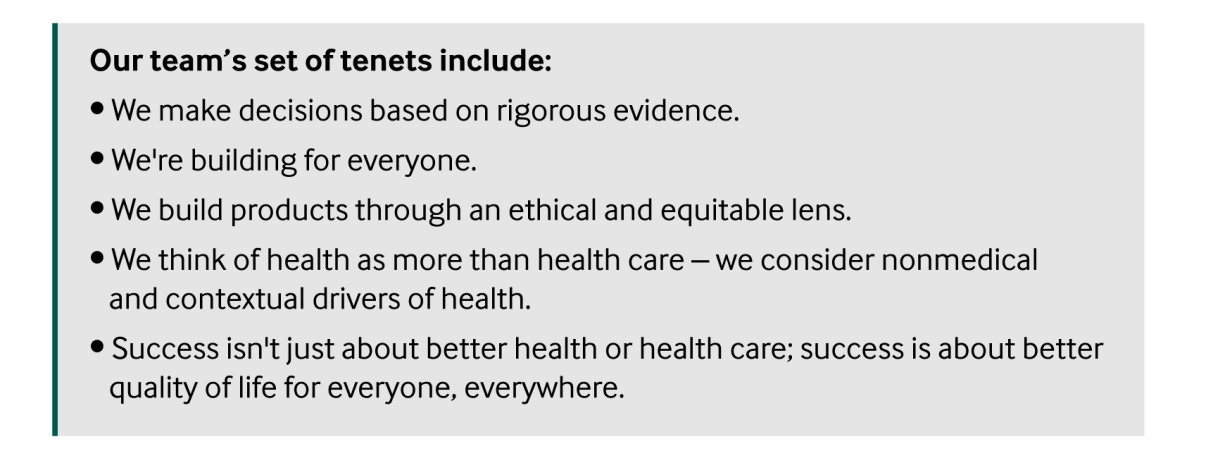

Lesson 3. Recruit for Talent — but Not Only for Clinical Expertise
Clinical expertise is table stakes, but clinical expertise without an innate product mindset, flexibility, and the ability to adapt and integrate into a new culture does not help anyone.20 To have impact, clinical knowledge must translate into something that helps product managers, user experience researchers, and engineers to create high-value products. Fundamentally, clinical team members must deeply understand not only the user and user journey, but also the product, technical, and business constraints. This understanding helps to translate clinical knowledge into product impact. Flexibility is also essential, especially while the clinical team is new. Clinical team members will often move between granular, highly detailed work one hour, to strategic planning the next, to partner-facing meetings shortly after. Over time, as the team grows, roles may become more specialized, but flexibility remains a core asset. Table 1 describes four key roles that clinical team members play at Google.
TABLE 1

For references: See original publication (full version)
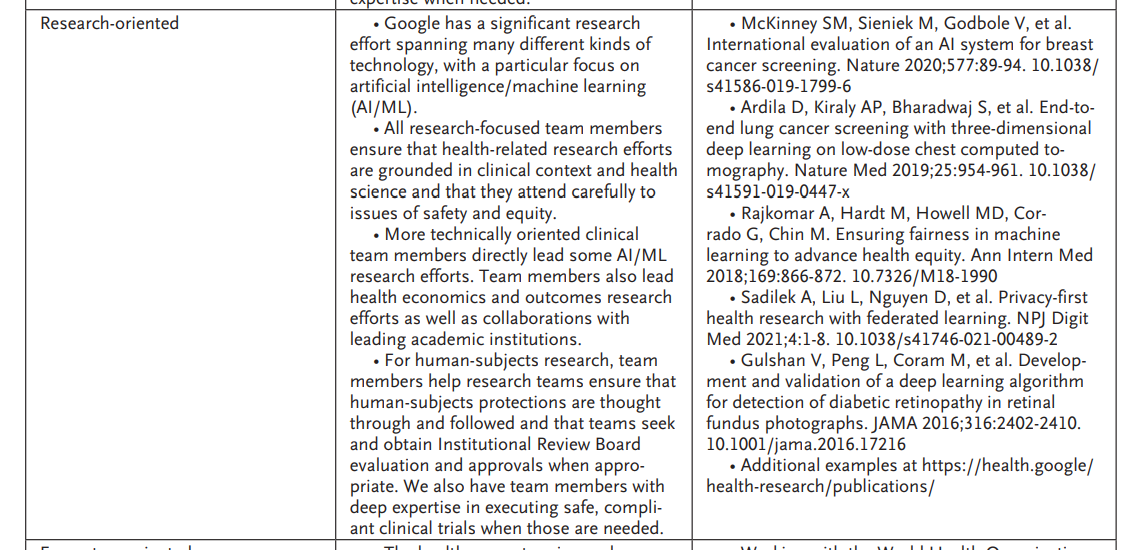

Another key characteristic is humility. This characteristic is critical not just for cultural adaption, but also for the agility to flex roles depending on the needs of the product or team. For clinicians, especially physicians, moving from a health care–focused institution to one where health care is only part of the business portfolio can be a major shift because it places them outside the focal point of attention. Finally, cultural adaptation is critical to success in moving to a technology company. Clinicians need to adapt to the language of their new environment too: at Google, for example, this means that words such as Memegen, Noogler, and GUTS become part of successful team members’ daily lexicon.21 This cultural adaptation also includes learning the tooling of the environment, the mechanics of how ideas are debated, and the systems in which discussions happen.
Clinical teams should be diverse in race, ethnicity, gender, life experience, and health professional background/training. The evidence is overwhelming that teams made up of individuals with diverse backgrounds are better at solving hard problems.22 And, as in clinical settings, we believe that multidisciplinary teams have better outcomes.
We set recruitment and retention priorities accordingly. While still a work in progress, our clinical team today includes individuals whose lived experiences reflect many axes of diversity: from past professional lives encompassing academia, public health, government, industry, and clinical practice, to personal histories spanning global geographies and intersecting identities.
First, teams of health professionals include individuals from a variety of career backgrounds (e.g., medicine, nursing, pharmacy, public health) to ensure that multiple points of view are brought to bear in decision-making across the product lifecycle. We look for professionals with work experience beyond academic health care settings, including those with safety-net and global health experience. Second, we know that team members with different life experiences create a stronger team because diversity improves outcomes.23 For example, companies seeking to address the upstream drivers of health should consider how their employees’ personal experiences with systems of racism, poverty, or other structural challenges may offer a unique lens for problem identification and solution creation.
The role of ‘clinician’ is a new function for technology teams, and new functions have inherent ambiguity.

Lesson 4. Develop Clarity on — and Build Consensus Around — New Ways of Working
The role of “clinician” is a new function for technology teams, and new functions have inherent ambiguity. One of the most important early jobs of a Chief Health Officer is to develop clarity about the particular role of clinicians on teams in the company and then to reach consensus on this point with other members of the senior leadership team. This clarity lets other functions (for example, product managers, engineers, and designers) collaborate successfully with clinicians and enables accountability for work and product outcomes. At Google Health, we reached consensus that clinical team members have particular accountability and responsibility for five key elements of each product, research program, or service (Figure 2).
FIGURE 2 — Key Accountabilities of Clinical Team Members
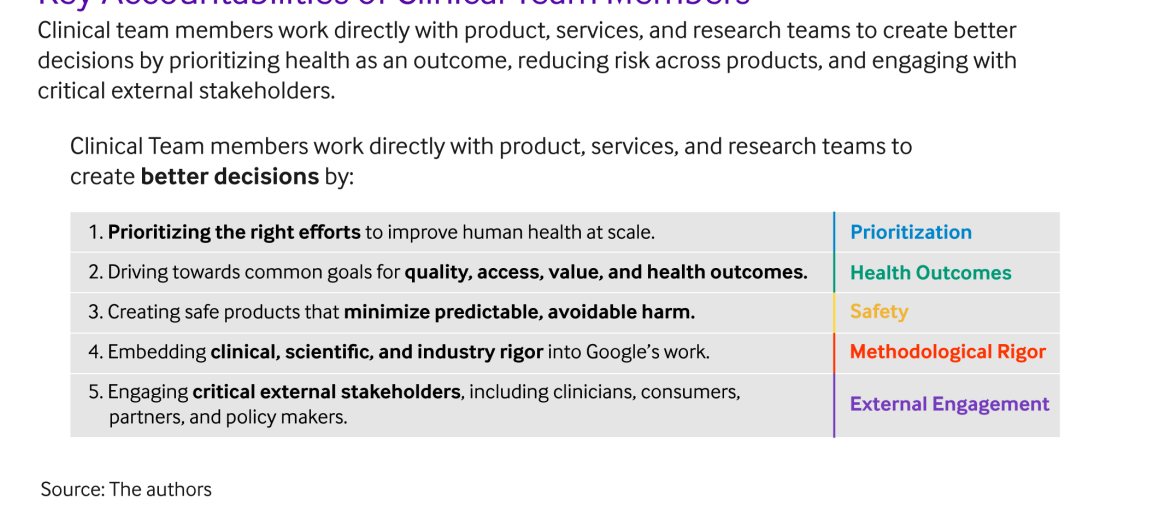
Companies also must avoid the potential risk that clinical engagements will follow a pattern of only one-off, ad hoc interactions. When teams first encounter clinicians, they often think of them as subject matter experts and utilize them just for ad hoc advising: “Can you tell me about the pancreas?” “How do patients get CT scans?” “What are ICD-10 codes?” While ad hoc advising has definite value, it does not reach the full potential of a blended team. At Google, we’ve sought to evolve from these one-off engagements to a spectrum of activity that spans true collaboration, cocreation, and leadership (Figure 3).
FIGURE 3 — Spectrum of Engagement of Clinical Team Members
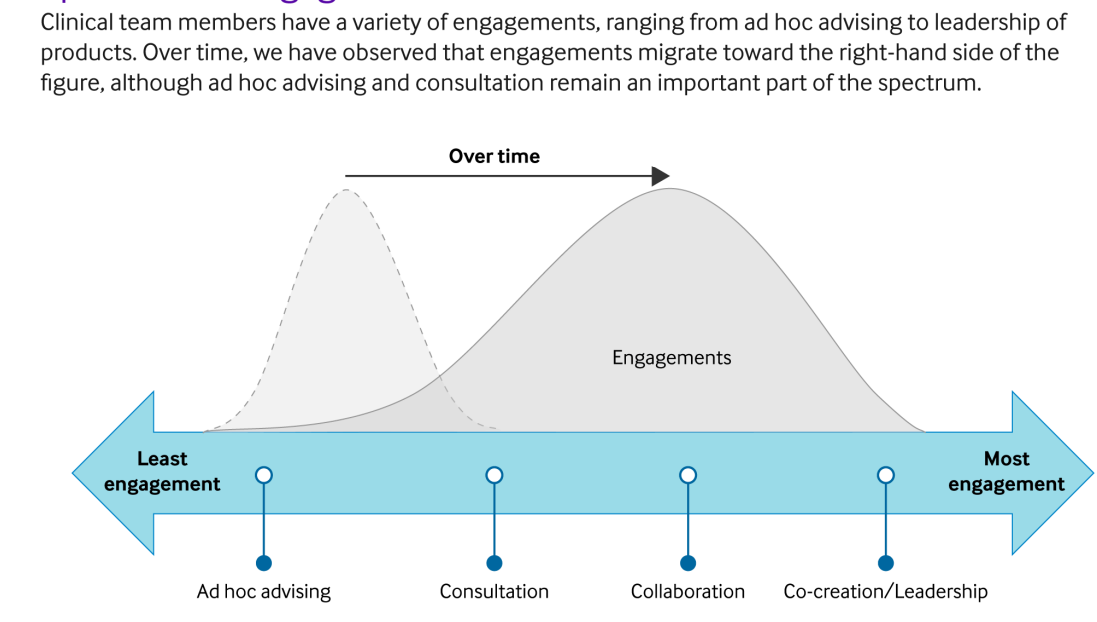
This transition from advising to collaboration and cocreation comes with a learning curve for both clinical and nonclinical team members. It takes time because it is a cultural change, but this integrated approach can meaningfully improve how we build products. For example, incorporating clinical expertise can bolster problem definition at the scoping stage, enhance user experience decisions at the design stage, strengthen methodological considerations at the testing stage, and improve communication and evaluation at the implementation stage. Demonstrating value comes in many forms: in products that work better (with typical metrics that are familiar across the company), in partnerships, in research discoveries, and in health metrics.24
If Chief Health Officers want to do more than play “on call” for the health problem du jour, then they need to emphasize teamwork over transience. While answering ad hoc questions is an educational exercise for all parties, referring back to a shared set of values and recruiting a diverse team of clinical experts can accelerate the process of demonstrating value for the broader company.

Lesson 5. Invest in the Infrastructure That Supports Career Progression
Technology companies have deep experience hiring, conducting performance reviews for, and promoting software engineers, product managers, and designers — but they usually do not have experience doing the same for employees with clinical or health professional backgrounds. At the outset, the only option may be to recruit clinical team members into existing company job roles, but, as the clinical team grows, more specificity is needed to ensure retention and professional progression.
While having a dedicated clinical team will be a new phenomenon for most companies, these teams will follow the life cycle of any new organization.
Establishing organizational structures to support clinical team members, including developing specific job ladders and performance review expectations that are customized to the work of the clinical team, is absolutely critical for success. While it may sound like a bureaucratic exercise, it is a leadership imperative because it’s a core part of being able to retain and grow clinical talent that can stay with the company and thrive professionally. Furthermore, such structures aid in recruiting new team members, especially those who are earlier in their careers, because they represent a demonstrable commitment to a path for expanding scope, impact, and responsibility.
Professional growth comes in many dimensions. For example, as demand for health expertise grows, some individual contributors become managers. Others learn new skills in other areas of the business: for example, some who have focused on enterprise-based efforts move into consumer health, and vice versa. And still others become part of teams that are bringing wholly new types of technology into the health space.

Lesson 6. Be Ready to Adapt, Grow…and Adapt Again
While having a dedicated clinical team will be a new phenomenon for most companies, these teams will follow the life cycle of any new organization.25 Consequently, leaders working on establishing these teams must be agile and continuously planning for their future evolution. In early stages of these clinical teams, it is common to have individuals playing multiple roles: nursing professionals who serve as product safety officers, physicians who check in code, clinicians who serve as product managers. This is analogous to a technology start-up. Early in a start-up’s lifecycle, it is common for product managers to contribute to the production code base. As organizations grow and evolve, roles become more specialized: product managers develop fully distinct roles from engineers. Similarly, the role of clinicians becomes more distinct over time. Informal influence becomes formal responsibility, and clinicians may have responsibility for company-wide policies and approaches that require the clinicians to focus on the roles and responsibilities for the broader team.
Understanding organizational life cycles has important implications, particularly when the team is transitioning from its start-up phase to being a more established function. For example, it is entirely feasible for clinicians to function as product managers, program managers, or even engineers. However, we have learned that it is important to separate those roles to ensure that the clinical point of view is represented when a clinician takes on a different formal role in product development. This distinction is no different than in health care: physicians are often hospital CEOs, but they do not simultaneously serve as Chief Medical Officers. It is also important to recognize that context can rapidly change and that leaders must adapt. Nothing demonstrates this contextual shift better than Covid-19. At Google, we had already been building the clinical team, but the pandemic changed the context of our work.
Covid-19 became the largest information need for Google’s users. The need and value of clinical team members was readily apparent. The company leaned in to focus on building products that helped users understand a changing world, whether that was learning about a new pathogen, fighting misinformation, or finding a Covid-19 test.26–28 We also supported public health officials through products such as Exposure Notifications and analytic tools such as Community Mobility Reports.29,30 Recognizing this context change was critical for how the clinical team worked.
As the pandemic continued, the context changed again. Vaccines made astonishing progress, and it was clear that the needs of our users would change. Partnering across the company, we focused on lifting up accurate and timely information on Covid-19 vaccines, fighting misinformation, and supporting vaccine equity.31,32 These context changes could be seen in users’ actual needs (Figure 4), as queries for “vaccine near me” increased more than fivefold from the beginning of 2021. Seeing this impending context change let us be ready to support users as vaccines became more widely available.33
FIGURE 4 — Examples of Evolving Information Needs
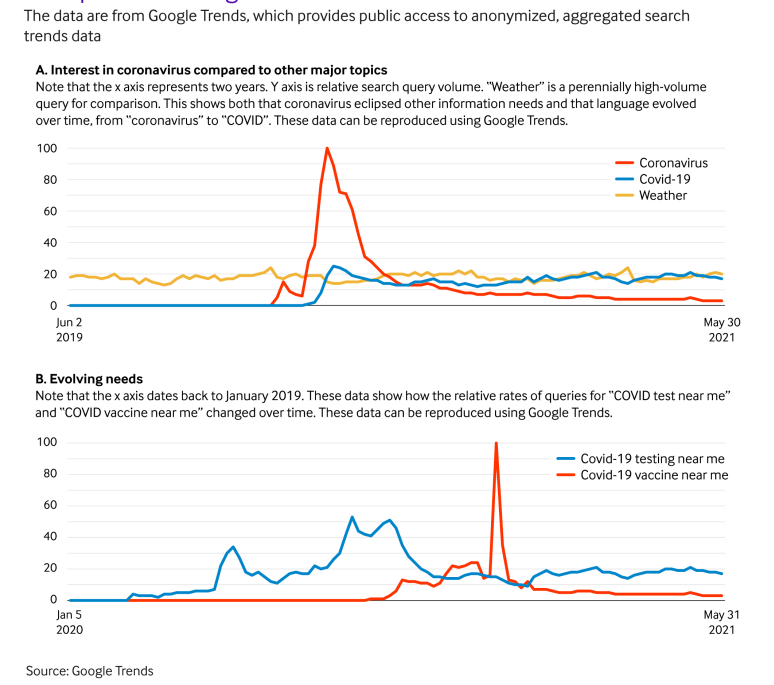
The pandemic will eventually end, but the health challenges facing the world will only continue to grow. Sustaining momentum for health in companies beyond Covid-19 requires Chief Health Officers to build teams capable of both delivering value in the present and evolving in response to the future.

The Road Forward
Embedding robust, thriving clinical teams in major technology companies is an opportunity for realizing the promise of improving human health at scale. We hope that companies embarking on this path may benefit from lessons that we have learned, including the critical need to define the enterprise-wide role of health, to develop a shared set of clinical values, and to invest in recruitment and operational strategies capable of evolving over time. Progress always begins by building a diverse team with the right people, by clarifying new ways of working, and by having an agile approach to continuously iterate on team construct.
References:
See the original publication https://catalyst.nejm.org




